If you’re a proud cat parent of multiple furry friends, you know that choosing the right litter box can be a bit of a challenge. With different personalities and preferences, it’s essential to find a solution that keeps everyone happy and your home odor-free. It’s not just about picking any box; it’s about creating a comfortable space for each cat to do their business.

Understanding the Needs of Multiple Cats
When I share my home with multiple cats, I notice how each one has unique needs. Understanding these needs helps me create a happy and stress-free environment. Every cat deserves a space that feels safe and comfortable.
Factors to Consider
Number of cats: I always keep in mind the number of cats using the litter box. A good rule is to have one litter box per cat, plus one extra. This arrangement reduces competition and mess.
Size of the box: I look for a box large enough for my cats to move around freely. A box measuring at least 24 inches long works well for most cats. Bigger cats may need larger boxes.
Type of litter: The type of litter matters. I try unscented clumping litter since most cats prefer it. Some cats have sensitivities to fragrances, so it’s best to avoid them.
Lid and entry style: I choose between covered and uncovered boxes. Covered boxes provide privacy, but some cats dislike them. I often experiment to see what my cats prefer.
Location: I place litter boxes in quiet areas, away from food and water. Cats like privacy when using the bathroom. If the box is in a high-traffic area, they might avoid it.
Common Challenges
Territory disputes: When multiple cats live together, I sometimes see them claiming territory. If one cat starts guarding the litter box, it can stress others. I make sure to have enough boxes to reduce this problem.
Peeing outside the box: If a cat starts peeing outside the box, it could mean stress or health issues. I check for problems and adjust the situation. Sometimes, offering an additional box helps.
Litter preferences: Not all cats like the same litter. Some prefer fine grains, while others might like larger pellets. I pay attention to my cats’ reactions and adjust as necessary.
By considering these factors and challenges, I create a better litter box experience for my cats. Keeping their needs in mind helps ensure a happy home for us all.
Types of Litter Boxes
Selecting the right type of litter box is key for homes with multiple cats. Different options cater to various cat needs and preferences.
Open vs. Covered Litter Boxes
Open litter boxes provide easy access for cats. They allow cats to see their surroundings, which can ease anxiety. Many cats prefer this type for that reason.
Covered litter boxes offer privacy and may help contain odors. They keep litter inside better and prevent spills. However, some cats feel confined in these boxes and might avoid them. Observe your cats to see which style they prefer.
Self-Cleaning Options
Self-cleaning litter boxes offer convenience for busy cat owners. These boxes automatically scoop waste into a separate compartment after use. This feature reduces odor and keeps the area cleaner.
Some self-cleaning boxes require specific types of litter. Make sure to review the requirements before purchase. Not all cats like these boxes, so monitor their reactions during the transition.
Size and Capacity
Choosing the right size and capacity for a litter box is crucial for multiple cats. A spacious box keeps cats comfortable and encourages them to use it.
Determining the Right Size
For each cat I have, I aim for a litter box that’s at least 24 inches long. This length provides enough room for my cats to turn around and dig. If my cats are larger breeds, like Maine Coons, I consider a bigger box. More space equals less stress.
I also think about how many litter boxes I need. The rule of thumb is one box per cat plus one extra. If I have three cats, I get four boxes. This setup minimizes conflicts and helps keep the peace.
Capacity Considerations for Multiple Cats
Capacity matters as much as size. Each box should hold enough litter to handle multiple uses throughout the day. I use at least 3 to 4 inches of litter. This depth helps absorb moisture and control odors.
I keep an eye on how often I scoop. For multiple cats, daily scooping is best. It keeps the box clean and encourages my cats to keep using it. A dirty box often leads to accidents outside the box.
Selecting the right size and capacity makes my home happier and healthier for my feline friends.
Litter Box Placement
Choosing the right spot for a litter box is important. The location affects the box’s usage and cleanliness. Cats prefer privacy, so consider their comfort when placing the box.
Ideal Locations
Place the litter boxes in quiet areas. Look for spots where your cats feel safe. Good locations include:
- Laundry rooms: Often quiet and away from traffic.
- Basements: Usually private and calm.
- Spare rooms: Allows for a less busy atmosphere.
Cats appreciate a little privacy while doing their business.
Avoiding Busy Areas
Avoid placing boxes in high-traffic areas. Cats may feel stressed in busy spots. Don’t place them near:
- Food and water bowls: Cats prefer separate areas for eating and using the box.
- Loud appliances: Avoid rooms with noisy washing machines or HVAC units.
- Main walkways: Keep boxes away from places where people frequently walk.
By keeping boxes in peaceful spots, cats feel secure and are more likely to use their litter boxes consistently.
Maintenance and Cleaning
Keeping a litter box clean is key for happy cats. A clean box reduces odors and prevents litter box avoidance. Regular maintenance leads to a healthier environment for my cats.
Frequency of Cleaning
I scoop the litter box at least once a day. Scooping often keeps the box fresh and encourages my cats to use it. Depending on the number of cats, I may need to scoop more frequently. Deep cleaning the box happens weekly. I wash it with warm water and mild soap, ensuring no strong scents remain. After washing, I let it dry completely before adding new litter.
Choosing the Right Litter
Selecting the right litter makes a big difference. I prefer unscented clumping litter as it controls odors and is easy to clean. Clumping litter forms solid balls when moist, making scooping simple. Some cats might like different textures or types. I try different options until I find the one my cats prefer. Keeping the litter depth at about 3 to 4 inches helps with clumping and reduces mess. Regularly changing the litter and cleaning the box keeps my cats feeling comfortable and content.
Conclusion
Finding the right litter box for multiple cats can feel overwhelming but it’s so rewarding when you see your furry friends happy and comfortable. By considering their individual needs and preferences you can create a space that works for everyone.
Remember to keep an eye on their behavior and adjust as needed. It’s all about trial and error to discover what works best in your home. With a little patience and attention to detail you’ll foster a stress-free environment that keeps your cats content.
Happy litter box hunting!
















